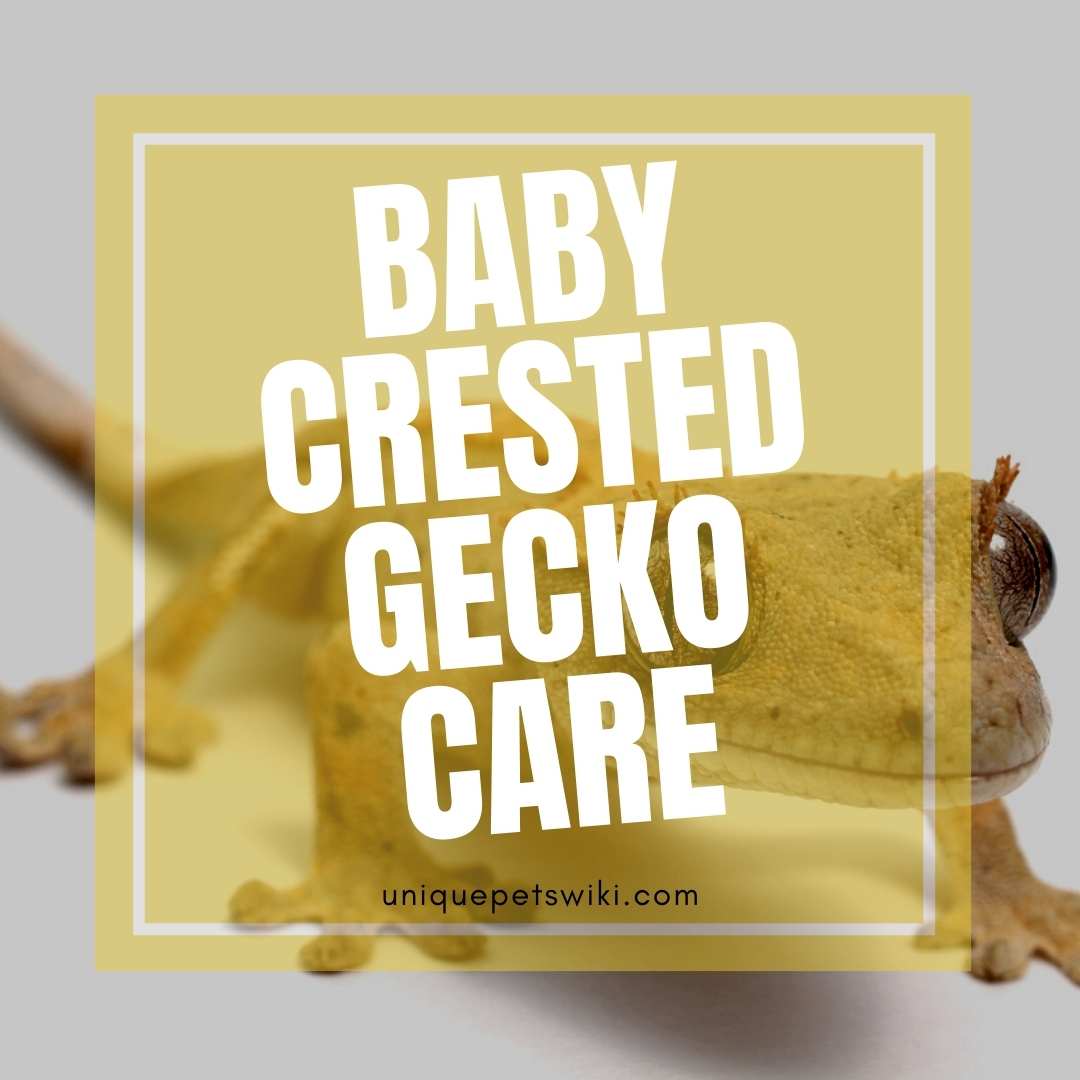Baby crested geckos are also known as hatchling and juveniles. Unlike many reptiles, baby cresties need similar care as adults but require special housing and humidity to shed their skin.
Although baby and juvenile crested gecko care are not difficult, you will need to be more careful while handling them. Young cresties are actively growing and will use more of their food resources and energy for growth. This means they rarely get overweight if they are fed with a balanced diet.
In this article, you will learn in detail about baby crested geckos and how to take care of them. You will also get an insight into the best ways of handling them.
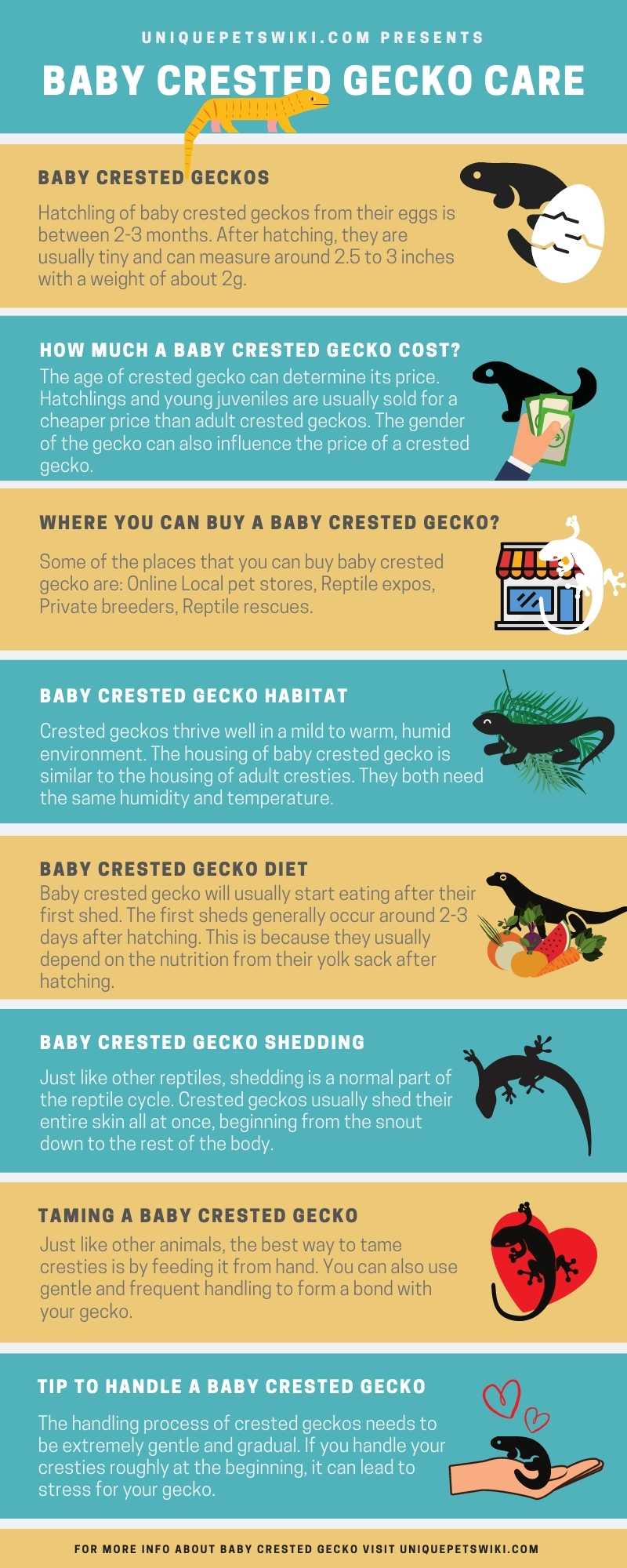
Contents
Baby Crested Geckos
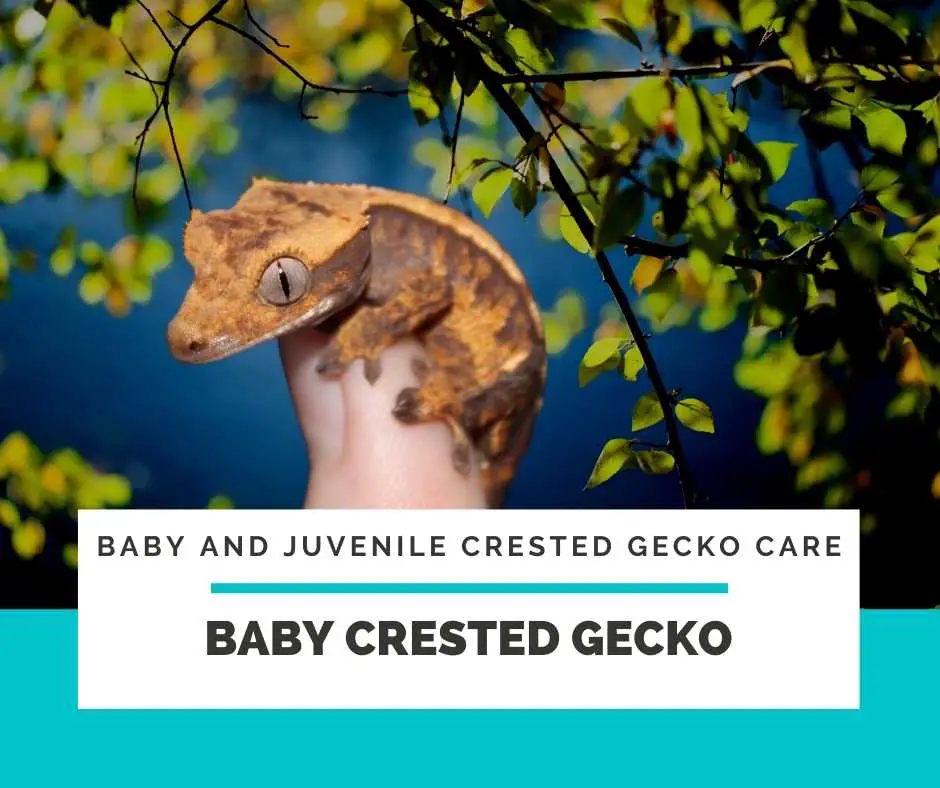
Hatchling of baby crested geckos from their eggs is between 2-3 months. After hatching, they are usually tiny and can measure around 2.5 to 3 inches with a weight of about 2g. The size and weight of cresties will be based on several factors like incubation temperature and genetics.
However, it is best to weigh and measure your baby cresties every week. You can use a kitchen scale for weighing them.
New to crested gecko? Check out the crested gecko care sheet now! We had listed out all the things you need to know about crested gecko as pets. Check it now!
How Much A Baby Crested Gecko Cost?
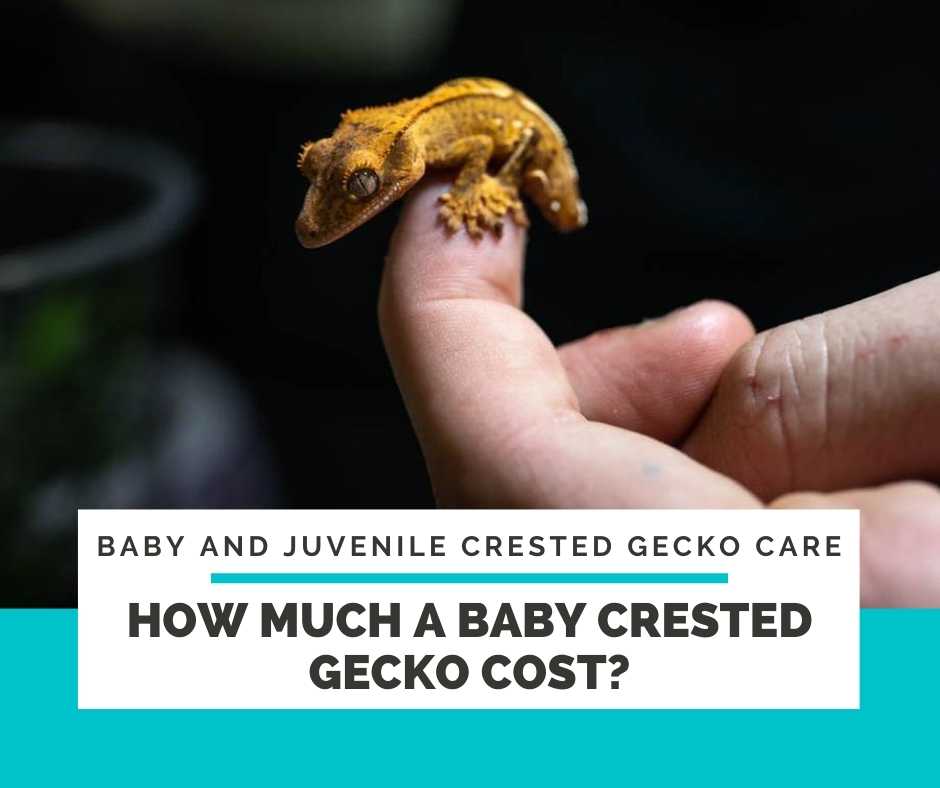
The age of crested gecko can determine its price. Hatchlings and young juveniles are usually sold for a cheaper price than adult crested geckos. The gender of the gecko can also influence the price of a crested gecko.
However, you will need to budget around $50-100 for a young crested gecko from a reputable breeder.
Where You Can Buy A Baby Crested Gecko?
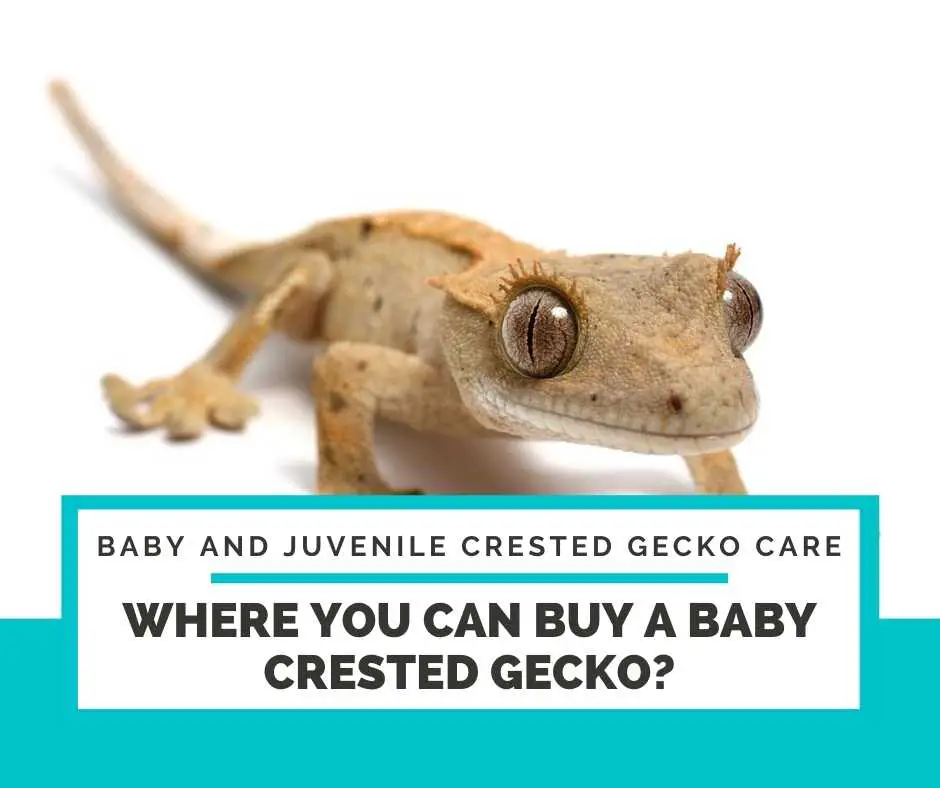
You can get crested gecko in almost anywhere in the world. However, it is easier to get crested geckos in the United States because they are more popular. Some of the places that you can buy baby crested gecko are
- Online
- Local pet stores
- Reptile expos
- Private breeders
- Reptile rescues
Note: It is not all breeders that are good people, as some will put profit over the health of the gecko. It is best to ask for enough information about a gecko before you opt to buy them. You should also be on the lookout for signs that the gecko is healthy and does not suffer from any health issues.
Baby Crested Gecko Habitat
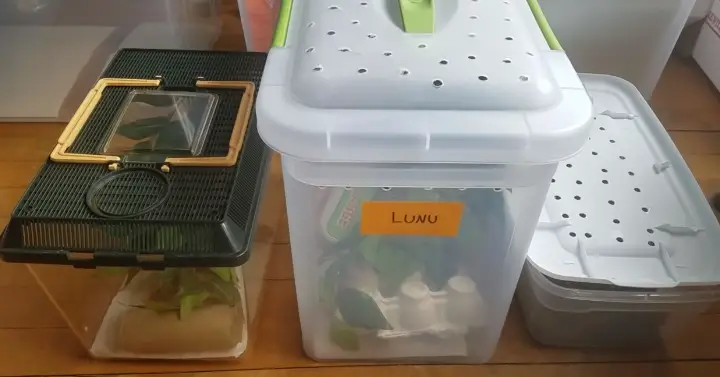
(Source: Sostic YouTube)
Crested geckos thrive well in a mild to warm, humid environment. The housing of baby crested gecko is similar to the housing of adult cresties. They both need the same humidity and temperature.
However, the major difference in the housing of baby crested geckos is the enclosure, plants, and substrate. You will also need to provide them with a tall glass enclosure with front and top ventilation to prevent overheating.
Enclosure for Baby Crested Geckos
You will need to keep baby crested geckos (about 10g) in a small container instead of a terrarium. You can also keep them in a smaller container or tank with a minimum size of around 1.5 and 5 gallons like a critter keeper or faunarium.
The best enclosure for juveniles between 10-25g is a small terrarium around 7-10 gallons. A smaller enclosure is suitable for hatchling and juveniles because they have trouble finding food in a larger tank. This is why you need a small environment with few plants or branches for them.
There are cases where adult cresties have trouble adjusting to a larger tank because they are not used to it. The best way to get crested gecko adjusted to a larger sized terrarium is by switching gradually to larger enclosures once the baby grows.
Substrates for Baby Crested Geckos
Because baby crested geckos are tiny, you cannot use the same kind of substrate used for adults for them. You will need a substrate with low ingestions risk for baby cresties and one that can be cleaned easily.
It is best to use paper substrates for baby crested geckos. Paper substrate is cheap and safe for baby geckos to walk on. You can either use paper towels or old newspapers for their tank.
You can even continue to use paper substrates as they grow older. However, there is a possibility that your hatchlings can tear the paper and try to eat it. If this happens, you can use a butcher paper, which is quite sturdier and harder to tear.
Another option when it comes to substrates for baby crested gecko is not to use substrates at all. However, this can lead to a buildup of water on the terrarium’s surface because of high humidity. It can also cause bacteria buildup.
You will need to be cleaning the tank every day to avoid this problem.
However, you can keep older juveniles in a terrarium with naturalist substrate. But it is best to wait until they are adults before you place a substrate with an ingestion risk in their tank.
Terrarium Plants and Branches
Placing terrarium plants in your baby crested gecko enclosure is pretty useful to them. It serves as a hiding place and options to climb around and explore the tank.
Although live terrarium plants help to increase humidity and give a more natural look to a tank, fake vines are a better option for baby crested gecko tanks. You can simply place one or two small branches with small fake plants to create hiding places for them.
However, ensure that about half of the container is free of plants like the adult crested gecko’s tank. When they grow older, and you transfer them to a large terrarium, you can start keeping live terrarium plants.
Hides
Just like adult crested geckos, baby cresties are nocturnal, and they love humid hides. Humid hides are small containers with a moist substrate.
You will need to provide one for your geckos to snooze and hide during the day. Providing a humid hides also helps baby crested geckos with shedding problems.
Temperature
Baby cresties will do well in temperatures between 70-80 degrees Fahrenheit. Their enclosure temperature should not go above or below the optimum temperature for a long time.
It can lead to heat stress and other health issues for your geckos. Baby crested geckos also need high humidity levels between 70-85%. However, humidity does not need to be high all the time.
Baby crested geckos can dehydrate easily, and there is a need for regular misting of their tank. You can also provide a water bowl for them to drink whenever they need it.
Lighting: What are the Lights Need for A Baby Crested Gecko?
Many gecko keepers believe that crested geckos do not need special UVB lighting because they are nocturnal. However, providing cresties with a low level of UVB lighting is beneficial for their overall health.
You can provide their tank with indirect sunlight or artificial light for 12-14 hours a day. However, they do not need special lighting at night.
Baby Crested Gecko Diet
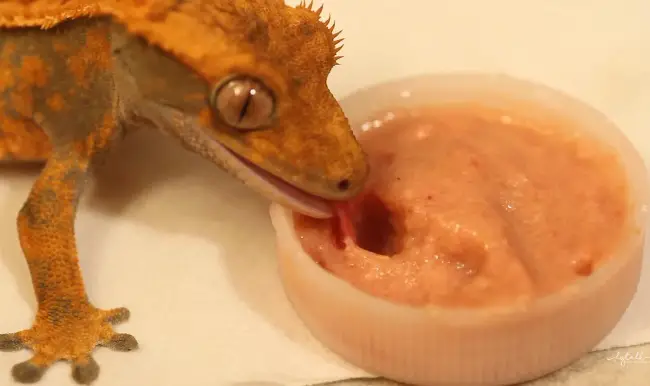
Baby crested gecko will usually start eating after their first shed. The first sheds generally occur around 2-3 days after hatching. This is because they usually depend on the nutrition from their yolk sack after hatching.
You can then start providing them with a crested gecko diet after their first shed is complete. Also, ensure you mist them and their enclosure twice a day to help improve their appetite.
New to crested gecko? Check out the crested gecko care sheet now! We had listed out all the things you need to know about crested gecko as pets. Check it now!
How Often do Baby Crested Geckos Eat?
Although baby cresties do not have to eat every day, they can eat every other day like adult cresties. It is best to feed them every day for growth promotion.
You can also feed them with fresh, premix food every other day. But you can leave the remaining food until you want to change to a fresh batch. This helps to give them the option to eat whenever they want.
Dietary Basics
Baby crested geckos will start eating after its first shedding, which occurs between 2-3 days after hatching. However, you can start placing food in their tank 24-48 hours after hatching to be certain your gecko has food.
Crested geckos are omnivores and can feed on both animal and plant matter. It is best to use commercial crested gecko food for baby crested gecko. This is because they have all the nutrients that your baby cresties need for healthy growth.
Feeding Insects to Baby Crested Geckos
You can introduce insects to the diet of your baby cresties around a month after hatching. However, ensure the insects are not bigger than the width of their head.
When feeding baby crested gecko with insects, ensure you gut-load and dust the insects with calcium and Vitamin D3 powder. You can feed them with two insects every other day.
Water
Baby cresties need water as they get easily dehydrated. They usually drink droplets of water that remain after misting. However, you will need to put a water bowl in their tank.
Ensure the water bowl is with a shallow amount of water to avoid your gecko’s accidental drowning.
At Which Age My Crested Gecko Needs The Juvenile Diet?
After six months, you can start feeding your crested gecko with a juvenile diet. You can feed them every other evening during the week with premixed powder. However, you will remove uneaten premix the following morning.
Because juvenile cresties will not eat during the day, and during the weekend, you can provide live food for them to improve their hunting skill.
Shedding
shedding is a normal part of the crested gecko cycle. Crested geckos usually shed their entire skin all at once, beginning from the snout down to the rest of the body.
How Often do Baby Crested Geckos Shed?
Unlike adults crested gecko, baby cresties shed their skin more often as they are actively growing. However, you may not see it as they shed but will shed once every other week. If you are lucky, you can catch them shedding at night.
Do My Crested Gecko Need Calcium After Shedding?
You do not need to provide them with calcium after shedding. This is because they eat their sheds to help recapture some of the nutrients used for creating new skin.
However, you can maintain a healthy shed by supplying their tank with the optimal amount of humidity by misting every day. You should monitor them during the shedding period for incomplete shedding.
Taming a Baby Crested Gecko
Taming your baby crested gecko is usually simple if you give it enough time to get used to you. Just like other animals, the best way to tame cresties is by feeding it from hand. You can also use gentle and frequent handling to form a bond with your gecko.
It can be hard to tame a baby crested gecko less than six months old. It is even more challenging to bond with baby crested geckos in their initial three months after hatching. During this period, the crestie is getting acclimatized to its environment.
You will need them to get used to its surroundings before you tame it. Although you can start taming your cresties after three months, it is best to leave them until after six months.
When taming crested geckos, ensure you take things slow and easy. Avoid rushing to pick them out of their enclosure. After your crested gecko has acclimatized with its new tank, you can then give it time to get used to your presence.
You can start to make your presence felt by the crested geckos. This is because they cannot see very well, but their sense of smell is fairly well. Once they can sense your presence repeatedly, this will help them determine you are not a threat.
After this stage, you can decide to make serious attempts to handle and bonding with them.
Tip to Handle a Baby Crested Gecko
The handling process of crested geckos needs to be extremely gentle and gradual. If you handle your cresties roughly at the beginning, it can lead to stress for your gecko. Some of the tips that can help initiate handling process successfully are:
You can assist acclimatization of your gecko by replacing food and water in the late afternoon when your gecko is asleep to reduce stress. It is also best to change their paper towel weekly.
Try to create a calm environment before handling your cresties. It is best to use a room without noise or kids running up and down. You will shut the doors and windows before placing your crested gecko’s enclosure on the floor.
If you have a jumpy gecko, it is best to try handling them during the day. This is because they will be more alert at night and ready to run.
You can start handling your cresties slowly when you are cleaning the enclosure. Instead of grabbing them, you can simply put them on a branch or a cardboard tube.
Start by using the hand walking technique to handle them. You will allow your gecko to run or jump from one hand to the other. This process is usually effective as you, and your gecko will get used to it very quickly.
When hand walking your cresties, try to do it for a minute or two at a time every other day after they have acclimatized to their tank. You can then increase hand walking them to around 15 minutes afterward.
After some months, your gecko will be used to handling them during the evening. However, you should expect that they will dart away at times.
Note
- Crested geckos are extremely fearful creatures and can easily be stressed by unfamiliar environments or noise. You will need to handle them carefully and give them enough time to get used to your presence.
- Rough or improper handling can easily create a sense of fear in your gecko.
- As the handler, ensure that you do not create a sense of fear in your cresties. You will need to handle them with confidence because crested gecko can make a hissing noise when the owners try to handle them.
- Some owners get put off by the noise. However, you will need to remain confident if you want to bond with your gecko.
